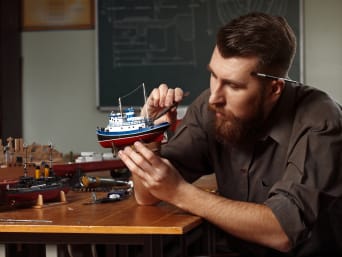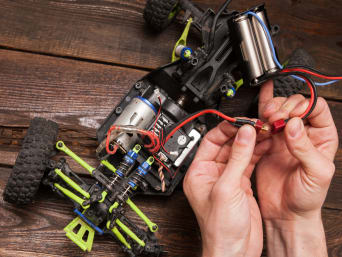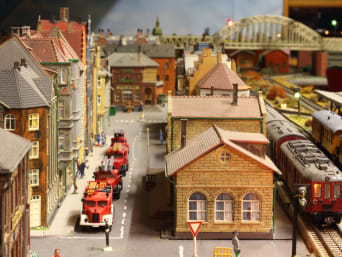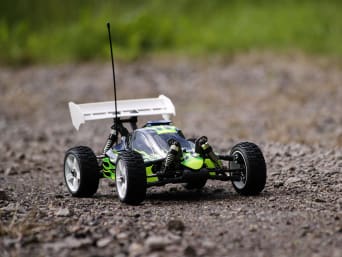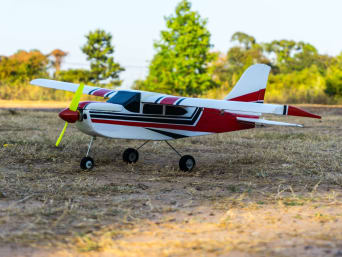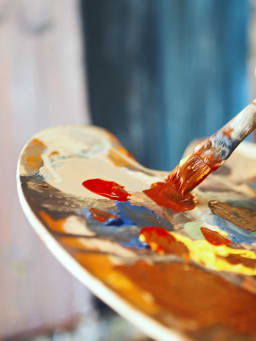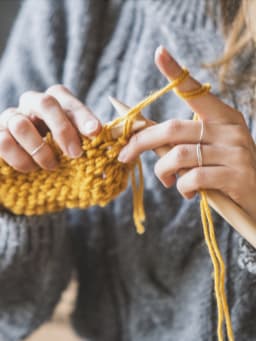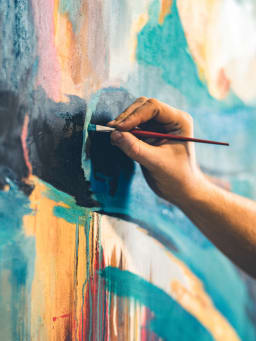Model making & RC model making for beginners
If you are looking for a new activity that will help you to relax and switch off from everyday life, then model making is the perfect hobby for you. There is something for everyone when it comes to model making, whether you love making model buildings, recreating landscapes, building vehicles, aeroplanes or driving a RC car around the countryside. In this article you can find out more about model building for beginners and we will show you how to get started with RC model building.
Model making for beginners: is model making the right hobby for me?
Classic model making is all about creating a replica from many small parts, add loving details and finish your work of art with the right paint job. You create a miniature version of something that you can only dream of. When choosing the right beginner’s model, you should consider your interests. If you’re passionate about cars or other vehicles, that’s probably a good place to start. If you enjoyed playing with a model railway as a child, or if you have a desire to create your own world for your model railway, then this maybe the perfect choice for you. Model kits are available for many different interests. We have listed some popular categories below:
Vehicles (cars, vintage cars, trucks, emergency vehicles, agricultural vehicles, military vehicles, etc.)
Aircraft (historic aircraft, modern aircraft, helicopters, military aircraft, etc.)
Ships (historic ships, sailing ships, military ships, civilian ships, submarines, etc.)
Sci-fi (spaceships, space stations, rockets, etc.)
Landscapes, buildings, figures (e.g. for model railways)
Hobby model making: which is suitable for beginners?
If you have decided on a certain category or even a certain model, there are a few things you can consider before buying that will make it easier for you to get started. These are some tips to consider when buying the right model for beginners:
As a model building beginner, you should first take a close look at the packaging or online product description. Many manufacturers indicate the level of difficulty of a model. This will help you to assess whether a model is feasible for you and to progress steadily.
Pay attention to the construction of the model: You can either use easy-click systems, where you only need to put each part together. This makes your work easier because you usually don’t have to glue anything together. You can also opt for the classic model, where you follow the instructions and glue the different parts together and thus build your model from scratch. The choice of models is much greater, and you have the chance to improve your skills.
In addition to how a particular model needs to be put together and the level of difficulty, you should also think about the scale of your model. This tip is especially helpful if you are interested in model railways. The more space you have, the larger your scale can be.
With the help of these tips, you will be able to find a model that suits your ideas and abilities in your nearest specialist shop. If you are unsure, local dealers will be happy to advise you and may even be able to give you a good tip or two.

Beginner kits are a good starting point for those who want to dive into the world of model building. You get the model set along with all the other accessories that make it easier for you to build the model. You can get a taste of the hobby relatively inexpensively and see if you enjoy it.
Tips for model making beginners
The deep concentration and creativity needed when making a model allows you to switch off from the outside world. While you meticulously follow your construction plan and give your model personalised details here and there, you also train your fine motor skills and your concentration. In addition, you will learn a lot about history whilst working on historical models and can feel proud of your achievements when you have finished.
Before you assemble your first model, check the instructions carefully and get an overview of the steps you will have to take. This will help you to follow the individual steps and avoid making any mistakes. Once you have successfully completed your first model and you have taken a liking to hobby model building, you can start thinking about acquiring certain accessories and tools. Below we have listed some model making essentials you will need to build models:
Paints (either acrylics or enamel paints)
Fine brushes
Side cutters and a knife
Plastic glue
File and/or sandpaper
Rubber bands and clamps (to hold glued pieces together)
Tweezers
A clear surface to work on
With the help of this starter kit, you will be well prepared for the next sets and can constantly expand your equipment and skills. However, model making is not necessarily a hobby you have to pursue alone. It’s a great way to involve children and build great models together. You can also join model building clubs or groups to share your hobby with like-minded people, benefit from the experience of others and make new friends.
RC modelling: driving or flying remote-controlled models
RC modelling is all about movement and speed. RC stands for ‘Radio Controlled’ or ‘Remote Controlled’. This hobby is not so much about building a model with great details, but more about using the model in the field. RC cars, RC planes and RC boats are becoming increasingly popular. One difference to model building is that you can buy RC models already assembled and ready to fly or drive. However, you need to look after RC models as they need to be maintained and repaired regularly. If you want to build the model yourself, you have the option of following instructions or even designing it yourself. You can assemble lots of different parts and then test it.

When buying RC cars, RC boats or RC planes as a complete set, you should always read the instruction manual carefully beforehand. You will find a lot of information about the recommended settings, preparation for driving/flight and advice on how to maintain your RC model. You can also read about the correct handling of your model’s batteries.
Tips on RC modelling for beginners
With speeds of up to 100 km/h, RC cars can be quite quick on the practice track and provide pure thrills for the driver. However, it is advisable for beginners to choose a slower model to practice with, which will allow you to improve your skills.
Tip: RtR model sets (abbreviation for Ready to Run) are ideal for beginners. These complete sets contain everything you will need to get started.
Keep the following three points in mind when buying your first RC car:
Scale/Size: think in advance about where you want to drive your RC car. The most versatile models are in 1:10 scale. They are not too big and can also be driven off-road or in fields. If you only want to drive on flat roads and asphalt, a smaller model is also an option. However, if you want to drive primarily on muddy terrain, you should choose a larger model.
On-road, off-road or crawler: the decision between these three categories has a decisive influence on the strengths and weaknesses of your RC car. On-road RC cars are designed for flat roads and can reach high speeds, but they are not great for going off-road. Off-road RC models are made for off-road use. They can drive on uneven surfaces and even jump off-road. If you opt for a crawler, on the other hand, your RC car will travel more slowly, but it can cope with difficult terrains and even climb rocks.
Speed: as an RC model beginner, you should first choose a model that is robust and not too fast. A good guideline is 30 km/h. However, you can make sure that there are tuning options for your model when you buy it. This way, you can keep improving and adapt your model to your abilities. You should also choose an electric motor for your first car.
It is a good idea to talk to specialist dealers and get the best advice. Exchanges in RC clubs or visits to model making fairs can also help you to get started. In addition, RC enthusiasts in your area can recommend good places and test tracks as well as offer advice for your first test drive.
RC aircraft: which model aircrafts are suitable for beginners?
Flying your own RC plane is great fun and a great hobby to enjoy out in the fresh air with family and friends. However, before you fly your plane or perform aerobatic manoeuvres, you should first learn how to fly. RTF (“Ready to Fly”) model sets make it easier for you to get started because they provide you with everything you will need.
Below you will find some useful RC aeroplane tips for beginners:
Aircraft models for beginners: to learn to fly as quickly and easily as possible, beginners in model flying can rely on models that fly stably and are also reasonably weather-resistant. Electric gliders are a good place to start. Their V-shaped wings, which are attached to the top of the fuselage, make them stable in the air and easy to steer. RC planes for beginners are also often labelled Trainer or Trainee.
Size: the larger your model, the more resistant it is to the wind. However, larger models are more expensive than smaller ones. Beginners should start with a model with a 1400 mm wingspan.
Material: foam (Elapor or EPP) is a good material for beginners. They are light and stable and can be repaired easily with superglue (even by beginners).
If you are unsure which RC aircraft suits you, you can get advice from a specialist shop or seek help from a model flying club. There you are sure to find a mentor who will accompany you on your first flights and give you helpful tips along the way.
Tip: If you are unsure about RC aeroplanes, you can get advice from a specialist shop or a model aeroplane club. Some clubs also have their own models that you can use to practice with. By doing so, you will be able to find the right model RC aeroplane that suits you.

There are a couple of formalities that you need to bear in mind before flying your model aeroplane. In some cases, for example, you will need to extend your liability insurance to cover you in the event of any accidents. You will also need a permit from your country of residence. You can find more information about the current legal regulations on flying model aeroplanes on the European Model Flying Union website.
Conclusion: getting started with model making and RC modelling
Model making or RC modelling is a great hobby that can provide you with a welcome break from your everyday working life. The precision work or the action-packed testing of the model in the RC area is a lot of fun and increases your dexterity and your technical understanding. In addition, model building, or RC model building is a great hobby that you can share with children. The lovingly made models or driving/ flying can also be great leisure activities for children.
______________________________________________
References and further information:
https://emfu.eu/regulation
(Last accessed 20.11.2023)
https://www.horizonhobby.com/blog-beginner-guide-rc-cars.html
(Last accessed on 20.11.2023)
https://www.rc-airplane-world.com/beginner-rc-airplanes.html
(Last accessed on 20.11.2023)
https://www.toscaleblog.co.uk/blog/model-making
(Last accessed on 20.11.2023)
The image sources in this text are in chronological order:
Cover photo: iStock.com/Aksonov
1. Image in text: iStock.com/igor_kell
2. Image in text: iStock.com/pejft
3. Image in text: iStock.com/bighugcreative
4. Image in text: iStock.com/PimchanStock
